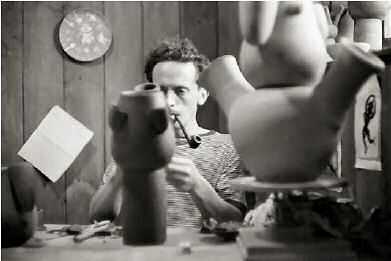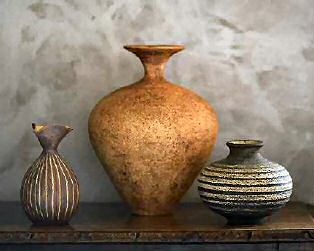September 27th to November 4th 2022
6 Dundas Street Edinburgh EH3 6HZ
25 Carnaby Street, London, W1F 7DE

Courtesy of The Fine Art Society ©DavidEustace

Courtesy of The Fine Art Society ©DavidEustace
The Fine Art Society held the first two of four exhibitions to celebrate British
potter Waistel Cooper (1921 - 2003) and his body of work in January and
February this year. The exhibitions were held concurrently in Edinburgh and
London and the second half of the retrospective will also be on view in both
galleries, opening from the 27th September and until the 4th November 2022.
2021 marked the centenary of artist-potter Waistel Cooper's birth. He was a
major force in the evolution of ceramics, leading the way in the 1950s for his
friends and contemporaries, Hans Coper and Lucie Rie, to overturn expected
potting aesthetics: eschewing elaborately decorated Victorian pots in favour of pure
forms and rough, textured, sculptural pieces. It was Cooper who scored a one man
show at Henry Rothschild's prestigious Primavera Gallery in the '50s, while Rie and
Coper exhibited there in mixed exhibitions, making ends meet producing buttons
and homewares, wondering in a letter to Cooper how he managed to follow his
own path. Were it not for Cooper's reticent nature - which ultimately led to his
living in the seclusion of the Culbone woods in Exmoor - he would be better known
today, and undoubtedly would claim the mid-century potting crown.
The extraordinary range of ceramics in the Fine Art Society's exhibition come from
the family of a close friend of Waistel Cooper, and they present us with a unique
opportunity to appreciate this brilliant potter's vision and skill, with the benefit of
hindsight and historical context. His visionary experiments with form and texture
captured the zeitgeist of post-war modern Britain.
Waistel Cooper Biography
Born in Ayr on the west coast of Scotland in 1921.
Attended the Ayr Academy, a traditional school with astrong art department.
Attended the Hospitalfield College of Art in Arbroath.
In the 1930s he was becoming aware of the important new developments in contemporary British sculpture, such as the organic work of Henry Moore and Barbara Hepworth.
In 1939 he was awarded a scholarship to Edinburgh College of Art, although his studies were soon interrupted by the war.
In 1941 he was invalided out of the Army, and in 1943 he resumed his studies in Edinburgh, where he first experimented with pottery in 1945.
He relocated to London where he shared a house with the Icelandic art historian Bjorn Theordor Bjornsson.
By 1946, taught in Reykjavik, with the Icelandic artist Gesture Thorgrimsson he built a kiln and prospected for clay, making earthenware pots decorated with coloured slips.
In 1950, he returned to the UK and Henry Rothschild, the owner of Primavera - an influential gallery - began to stock Waistel's work.
In 1954 he featured in the first exhibition of contemporary British studio ceramics en masse: 'Engelse Keramiek', at the Stedelijk Museum, Amsterdam.
In 1955 he held a solo exhibition at Primavera and further success came via the Department Stores, Liberty's, Dunn's of Bromley, and Heal's.
In 1959 he was included in the British Artist Craftsmen exhibition organised by the Council of Industrial Design and the Smithsonian, where his pottery was shown alongside works by Barbara Hepworth, Henry Moore, John Piper, Sir Jacob Epstein, Ben Nicholson, Elizabeth Frink and Graham Sutherland.
in 1959 he lived in Porlock, in a lodge isolated and surrounded by woodland, not easily accessed by vehicle. Here Waistel, inspired by flora and fauna, introduced fungi and other forms to his pottery.
The 1960s were his most successful period. His pottery had a clear and distinctive voice; a rough surface texture, earthy organic tones, ribbed, patterned or incised with glazed interiors.
His later pieces when he was living and working in Penzance, Cornwall, became even more abstract. His earthy woodland tones were exchanged for rough white and grey textures with azure blue interior glazes, and he produced monumental carved abstract sculptures of organic interlocking forms.
The exhibition can be viewed on the Fine Art Society website.
The Fine Art Society held the first two of four exhibitions to celebrate British
potter Waistel Cooper (1921 - 2003) and his body of work in January and
February this year. The exhibitions were held concurrently in Edinburgh and
London and the second half of the retrospective will also be on view in both
galleries, opening from the 27th September and until the 4th November 2022.
2021 marked the centenary of artist-potter Waistel Cooper's birth. He was a
major force in the evolution of ceramics, leading the way in the 1950s for his
friends and contemporaries, Hans Coper and Lucie Rie, to overturn expected
potting aesthetics: eschewing elaborately decorated Victorian pots in favour of pure
forms and rough, textured, sculptural pieces. It was Cooper who scored a one man
show at Henry Rothschild's prestigious Primavera Gallery in the '50s, while Rie and
Coper exhibited there in mixed exhibitions, making ends meet producing buttons
and homewares, wondering in a letter to Cooper how he managed to follow his
own path. Were it not for Cooper's reticent nature - which ultimately led to his
living in the seclusion of the Culbone woods in Exmoor - he would be better known
today, and undoubtedly would claim the mid-century potting crown.
The extraordinary range of ceramics in the Fine Art Society's exhibition come from
the family of a close friend of Waistel Cooper, and they present us with a unique
opportunity to appreciate this brilliant potter's vision and skill, with the benefit of
hindsight and historical context. His visionary experiments with form and texture
captured the zeitgeist of post-war modern Britain.
Waistel Cooper Biography
Born in Ayr on the west coast of Scotland in 1921.
Attended the Ayr Academy, a traditional school with astrong art department.
Attended the Hospitalfield College of Art in Arbroath.
In the 1930s he was becoming aware of the important new developments in contemporary British sculpture, such as the organic work of Henry Moore and Barbara Hepworth.
In 1939 he was awarded a scholarship to Edinburgh College of Art, although his studies were soon interrupted by the war.
In 1941 he was invalided out of the Army, and in 1943 he resumed his studies in Edinburgh, where he first experimented with pottery in 1945.
He relocated to London where he shared a house with the Icelandic art historian Bjorn Theordor Bjornsson.
By 1946, taught in Reykjavik, with the Icelandic artist Gesture Thorgrimsson he built a kiln and prospected for clay, making earthenware pots decorated with coloured slips.
In 1950, he returned to the UK and Henry Rothschild, the owner of Primavera - an influential gallery - began to stock Waistel's work.
In 1954 he featured in the first exhibition of contemporary British studio ceramics en masse: 'Engelse Keramiek', at the Stedelijk Museum, Amsterdam.
In 1955 he held a solo exhibition at Primavera and further success came via the Department Stores, Liberty's, Dunn's of Bromley, and Heal's.
In 1959 he was included in the British Artist Craftsmen exhibition organised by the Council of Industrial Design and the Smithsonian, where his pottery was shown alongside works by Barbara Hepworth, Henry Moore, John Piper, Sir Jacob Epstein, Ben Nicholson, Elizabeth Frink and Graham Sutherland.
in 1959 he lived in Porlock, in a lodge isolated and surrounded by woodland, not easily accessed by vehicle. Here Waistel, inspired by flora and fauna, introduced fungi and other forms to his pottery.
The 1960s were his most successful period. His pottery had a clear and distinctive voice; a rough surface texture, earthy organic tones, ribbed, patterned or incised with glazed interiors.
His later pieces when he was living and working in Penzance, Cornwall, became even more abstract. His earthy woodland tones were exchanged for rough white and grey textures with azure blue interior glazes, and he produced monumental carved abstract sculptures of organic interlocking forms.
The exhibition can be viewed on the Fine Art Society website.

×


